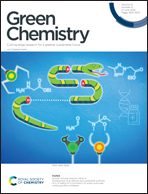Sustainable composites from poly(3-hydroxybutyrate) (PHB) bioplastic and agave natural fibre†
Abstract
A sustainable green composite based on poly(3-hydroxybutyrate) (PHB) and agave fibre was produced. The synergy between PHB bioplastic and agave natural fibre was investigated in the presence of an organic peroxide through one step reactive extrusion processing. The work focuses on controlling the crystallinity of PHB to tailor the mechanical properties, especially for improving the impact properties of highly brittle PHB. Optical microscopy showed a decrease in spherulite formation, and hence controlled reduction of the crystalline region of the PHB matrix, with the addition of agave fibre and peroxide treated fibre. Scanning electron microscopy showed the role of organic peroxide in improving the interfacial interaction in fibre matrix adhesion, and hence resulting in improved mechanical properties. An expected reduction in tensile strength of PHB was found with the addition of 25 wt% of agave fibre due to the reduction in crystallinity induced by the treated agave fibre. Interestingly, optimal composition of composites having 25 wt% agave fibre with 0.1 phr peroxide improved the flexural strength by 46%, impact strength by 45% and heat deflection temperature (HDT) by 39% compared to the neat PHB. An effective reactive extrusion of agave fibre and PHB in the presence of peroxide can provide a sustainable and cost-effective alternative to petroleum-based plastics for food packaging applications.



 Please wait while we load your content...
Please wait while we load your content...